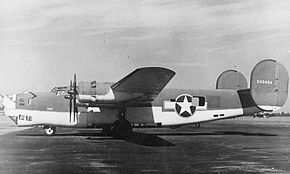Army Air Forces Antisubmarine Command
Army Air Forces Antisubmarine Command
 |
|
|---|---|

B-24 Liberator of AAF Antisubmarine Command
|
|
| Active | 1942–1946 |
| Country |
|
| Branch | Army Air Forces |
| Type | Command |
| Role | Antisubmarine warfare, then bomber training |
| Part of | First Air Force |
| Engagements |
American Theater of World War II European Theater |
| Disbanded | 8 October 1948 |
| Insignia | |
| Shoulder Sleeve Insigne (approved 8 January 1946 |  |
The Army Air Forces Antisubmarine Command was formed in the fall of 1942 to establish a single command to control antisubmarine warfare (ASW) activities of the Army Air Forces (AAF) under a single command. It was formed from the resources of I Bomber Command, which had been carrying out the antisubmarine mission since the Attack on Pearl Harbor in the Atlantic and Caribbean due to the lack of long range Naval aviation in that area.
The command's units conducted ASW along the Atlantic and Gulf coasts of the United States, in the Caribbean Sea and in Europe, where it used in England and French Morocco. Its operations were marked by disagreements between the AAF and the Navy concerning the conduct of air ASW. In the fall of 1943, the ASW mission was transferred to the Navy and the command became a bomber training unit until it was inactivated in 1946.
Within a day after the declaration of war by the United States the AAF began patrols of both the East and West coasts. Defense plans drawn up before the war began assigned the Navy responsibility for operations beyond the coastline, with Army aircraft serving in a supporting role. Because naval aviation that could perform long range patrols was nearly non-existent along the Atlantic coast in early 1942, the burden for aerial antisubmarine patrols fell on the Army Air Forces (AAF), which had available aircraft, but whose crews had not been trained for the mission.
German Navy submarines began operating in American coastal waters. By March 1942 fity-three ships had been sunk in the North Atlantic Naval Coastal Frontier. As a result, the Commander of the North Atlantic Naval Coastal Frontier requested the Army's Eastern Defense Command to undertake offshore patrols with all available aircraft.The first patrols were performed by elements of I Bomber Command, which would be the primary AAF command involved in antisubmarine warfare (ASW) in early 1942, with assistance from I Air Support Command. However, although I Bomber Command was primarily involved in conducting ASW, it was doing so on an emergency basis, and was subject to withdrawal from these duties to perform its primary bombardment function. It soon became apparent that if the AAF were to continue with the ASW mission, its units would have to be organized under a specially trained and equipped command.
...
Wikipedia
